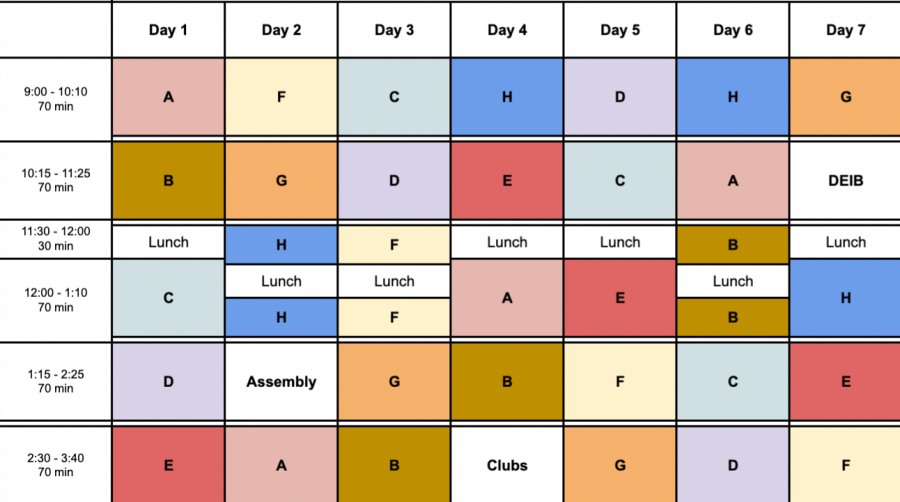The Consequences of The New Schedule
“Ah,” you exclaim, as you stretch out of bed, greeted by a sun already risen, an hour later than you’re used to, energized for a full day of school. The school arrival time at 9 a.m. matches students’ biological clocks to prevent sleep deprivation and, ideally, to learn at full capacity. Now, we’re all for sleep, but have you carefully considered the serious consequences?
Unlike our spring 2021 schedule, a leisurely day from 9 a.m. to 3 p.m., the 2021-2022 school-day runs an extra 40 minutes longer, with a dismissal at 3:40 p.m. Before the pandemic, each year, Poly slowly pushed dismissal further in the day from 2:40 p.m. to 3:10 p.m.to a now whopping 3:40 p.m. Not only did Poly lengthen the day, but increased class time too, from 40 minutes to 60 minutes, and, now, 70 minutes. College courses are typically 50 minutes long. Are 70-minute periods really maximizing student focus or diminishing it? As high school students, it’s incredibly hard to muster through a long day of learning to begin with, but how can we expect students to remain engaged under these circumstances?
Poly has granted students the option to take eight classes, a gift that allows many students the option of having a free period three times a week. On the other days, and those committed to filling their schedules, however, are on the go 24/7; the only break between five consecutive 70-minute classes is a brief 30 minutes for lunch. When you get to Commons and see the overflowing students on the lunch line, you already know there will be no time for homework, student-teacher meetings, or even any short-lived conversation. By the time you sit down to enjoy your meal, you are constantly checking the time as you prepare to scamper back to the class lunch split. Seniors, who are given the privilege of leaving during lunch, often have no time to leave campus even if they want to. Perhaps the administration shortened lunch to reduce the time masks are off, but how much more time are we willing to give up?
On top of the minimal lunch break, students have five minutes to rush to class. While this time is no different from previous years, it does not account for the taxing extra time spent in class. Students need a nice break before arriving at their next class: time to get to class, use the restroom, have a quick chat with a teacher, or run to print homework last-minute. Not to mention, the mere 20 minutes before the last class’s dismissal and bus departure or sports practices is not sufficient, especially when students and teachers are occupied the rest of the day. In those 20 minutes, students must sacrifice a snack, an academic meeting with a teacher, the pleasure of hanging out with friends, missing the bus, or being late to practice.
If the pandemic has taught us anything, it’s that students can learn with less time in a school day, especially if they are in person. Many students gained independence when virtual or otherwise could not communicate with teachers one-on-one. Students have learned to figure out things on their own—in some regards, a more effective way to learn. Rather than stretch every last brain cell, isn’t there a balance?
Certainly, life can’t be taught in books. You can say goodbye to all those special hobbies you developed during the pandemic days. Instead of mastering a perfect loaf of banana bread or taking a relaxing stroll around your neighborhood, you hop on the bus at 4 p.m. and suffer through rush-hour traffic, as 3:40 p.m. becomes more like a five o’clock dismissal.
At 5 p.m., you complete your homework, eat dinner, and guess what? It’s bedtime, but you likely stay up, working, learning, playing, or having fun, and the later wake-up time doesn’t matter. It’s at most seven hours of sleep no matter how you slice it, otherwise, there is no time to complete your homework or fulfill your commitments. Which do you choose?
Throughout the pandemic, while it was under different circumstances, Poly did a great job of ensuring that we always had school. What we lacked, though, was interaction between friends, a fair trade for reduced COVID transmission. Unfortunately, it is impossible for the school to compensate for this lost social time, especially with our new schedule adjustments. If we lose out on the things we gained and don’t gain back the things we lost in those 18 months, what was the point?
Here we are: the new school year that erases the pandemic. That’s just what we wanted. Right?
This editorial represents the majority view of the Polygon editors.


























